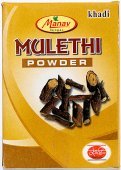Glycyrrhiza glabra: 4 definitions
Introduction:
Glycyrrhiza glabra means something in Hinduism, Sanskrit, biology. If you want to know the exact meaning, history, etymology or English translation of this term then check out the descriptions on this page. Add your comment or reference to a book if you want to contribute to this summary article.
In Hinduism
Ayurveda (science of life)
Cosmetics, Perfumery, Skin care and other Ayurvedic Beauty treatments
Source: Ancient Science of Life: Critical review of Ayurvedic Varṇya herbsGlycyrrhiza glabra (Sanskrit: madhuyaṣṭi) is the name of a medicinal plant used in Ayurveda to promote skin care and enhance the beauty of the skin (varṇya).—Glycyrrhiza glabra (liquorice) root offers skin depigmenting, lightening, emollient, anti-acne, photo protection, antiaging, antimicrobial and antioxidant properties, all helpful for a healthy skin. Role of G. glabra on skin is mainly attributed to its antioxidant activity of phytochemicals namely triterpene, saponins (Glycyrrhizin-salts of glycyrrhizic acid) and flavonoids. Glycyrrhizetic acid controls the secretion of melanin in skin and it has the effect of reducing dark pigmentation and making the complexion fairer. Methanolic extract of its rhizome has been reported to be a potent tyrosinase inhibitor in human skin with more than 75% inhibition. The IC50 value was found to be within range when compared to well known skin whitening agent i.e. Kojic acid. Therefore, it is likely to be useful for cosmetic applications.
Agriculture (Krishi) and Vrikshayurveda (study of Plant life)
Source: Asian Agri-History: Drumavichitrikaranam—The Ancient Approach to Plant MutagenesisGlycyrrhiza glabra (Liquorice) was used to produce Seedless Fruits: which was one of the technologies known to ancient Indian agriculturists, which presents a safe technology and methodology regarding organic agriculture, according to treatises (such as the Vrikshayurveda). One such technology was to produce seedless fruits: Seeds often impart a bitter taste, thereby causing an unpleasant experience while eating the fruit. Seeds also accelerate fruit deterioration. Hence seedless varieties of fruits have greater economic value. Use of Abrus precatorius (jequirity), Madhuca indica (butter tree), Saussurea lappa (costus), Glycyrrhiza glabra (liquorice), honey, sugar, and clarified butter is said to cause seedlessness.
Source: Shodhganga: Drumavichitrikarnam—Plant mutagenesis in ancient IndiaGlycyrrhiza glabra (in Sanskrit: Yaṣṭī) is used in various recipes for bio-organic manipulation of plants/flowers/fruits, according to the Vṛkṣāyurveda by Sūrapāla (1000 CE): an encyclopedic work dealing with the study of trees and the principles of ancient Indian agriculture.—For example, while describing the process of producing long lasting fruits (on the tree) [e.g., anāśi-phalatva]: “A ball made out of the mixture of flowers of the Madhuca indica, Nymphaea caerulea, honey, crystalline sugar and Glycyrrhiza glabra [e.g., Yaṣṭī] kept in a hole made at the root of a tree produces long lasting fruits (on the tree)”.

Āyurveda (आयुर्वेद, ayurveda) is a branch of Indian science dealing with medicine, herbalism, taxology, anatomy, surgery, alchemy and related topics. Traditional practice of Āyurveda in ancient India dates back to at least the first millenium BC. Literature is commonly written in Sanskrit using various poetic metres.
Biology (plants and animals)
Source: Google Books: CRC World Dictionary (Latin names; Binomial nomenclature)Glycyrrhiza glabra L. is the name of a plant defined in various botanical sources. This page contains potential references in modern medicine, Ayurveda, and other local traditions or folk medicine. It has the following synonyms: Amicia glandulosa Kunth, Glycyrrhiza alalensis X.Y. Li, Glycyrrhiza brachycarpa Boiss., Glycyrrhiza glabra Torr., Glycyrrhiza glabra subsp. glandulifera (Waldst. & Kit.) Ponert, Glycyrrhiza glabra var. caduca X.Y. Li, Glycyrrhiza glabra L. var. glabra, Glycyrrhiza glabra var. glandulifera (Waldst. & Kit.) Regel & Herder, Glycyrrhiza glabra var. glandulosa X.Y. Li, Glycyrrhiza glabra var. laxifoliolata X.Y. Li, Glycyrrhiza glabra L. var. typica L., Glycyrrhiza glabra var. violacea (Boiss. & Noë) Boiss., Glycyrrhiza glandulifera Waldst. & Kit., Glycyrrhiza hirsuta Pall., Glycyrrhiza pallida Boiss., Glycyrrhiza pallida Boiss. & Noe, Glycyrrhiza violacea Boiss. & Noë, Liquiritia officinarum Medik., nom. illeg. superfl..
References regarding Glycyrrhiza glabra L. for further research on medicinal uses or toxicity:
· Species Plantarum (1753)
· Descriptiones et Icones Plantarum Rariorum Hungariae (1800)
· Nova Genera et Species Plantarum (1823)
· Diagnoses plantarum orientalium novarum (1843)
· Diagnoses plantarum orientalium novarum (1856)
· Soc. Mose. (1866)
· Flora Orientalis (1872)
· Feddes Repertorium (1972)
· Acta Botanica Boreali-Occidentalia Sinica (1985)
· Current Science (1985)
· Anales del Jardín Botánico de Madrid (1988)
· Botanicheskie Materialy Gerbariia Instituta Botaniki Akademii Nauk Uzbekskoi SSR (1989)
· Bulletin of Botanical Research (1989)
· Caryologia (1990)
· Bulletin of Botanical Research (1991)
· Advances in Plant Taxonomy in Northwest China (1992)
· Bulletin of Botanical Research (1993)

This sections includes definitions from the five kingdoms of living things: Animals, Plants, Fungi, Protists and Monera. It will include both the official binomial nomenclature (scientific names usually in Latin) as well as regional spellings and variants.
See also (Relevant definitions)
Full-text (+105): Yashtimadhu, Klitaka, Madhuka, Yashti, Madhuyashti, Liquorice, Jashtimadh, Mithilakdi, Jalayashti, Madhuyashtika, Jethi-madh, Atimadhura, Mulhatti, Atimaduram, Neelipushapa, Sous, Jestamaddu, Yashtyawa, Yashtimaduka, Liquirizia.
Relevant text
Search found 3 books and stories containing Glycyrrhiza glabra; (plurals include: Glycyrrhiza glabras). You can also click to the full overview containing English textual excerpts. Below are direct links for the most relevant articles:
Matangalila and Hastyayurveda (study) (by Chandrima Das)
The Garuda Purana (by Manmatha Nath Dutt)
Chapter CCXXVII - Different names of the Ayurvedic Drugs < [Dhanvantari Samhita]
The Brahmanda Purana (by G.V. Tagare)
Chapter 14 - Purification rites and the Śrāddha ritual < [Section 3 - Upodghāta-pāda]
Related products
(+35 more products available)





